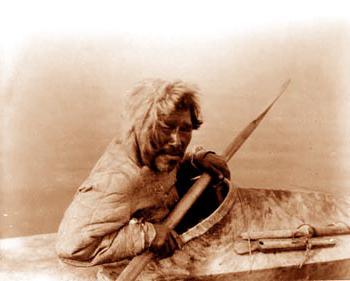The world knows a variety of devices to overcome water expanses. The boats were made by different peoples from the most unexpected materials; their choice depended on what exactly is rich in the area where this or that nationality lives. From this point of view, it seems to us the most interesting boat of the Eskimos, living, as you know, in very harsh conditions, in places poor in the materials most familiar to us. And at the same time, these northern hunters quite successfully engaged in the extraction of fish and marine animals.
Varieties of Eskimo boats
Any floating craft should be appropriate for its intended use. In the harsh northern conditions, the Eskimo boat could serve two purposes: hunting, that is, procuring food, and transportation. Accordingly, the transport ship was called "umiak" and was a rather wide boat with an open top, where it was possible to store cargo. Umiak was also considered a female vessel, since they were mainly involved in transportation. In turn, the Eskimo fishing boat was called a kayak. It was made completely waterproof, tightly closed from above - there was only a hole plugged by the body of the hunter. The kayak was very narrow and nimble, with good maneuverability.
What were the Eskimos boats made of
In the Far North, in the place of the original habitat of this nationality, the tree is in great shortage. However, the skeleton that the Eskimo boat had was still wooden. A fin was going for him - a forest worn over the years by ocean waters. Over time, when ships began to come to these distant shores, the Eskimos began to exchange ready-made boards for the results of the hunt. Preference, however, was still given to the floating forest, since it is much lighter than boards.

The wooden base was covered with walrus or seal skins taken from the animals that had just been killed. If the skin was taken “stale”, then it had to be soaked for a long time in salt water and beat off so that it became elastic again. Covered in leather, the Eskimo boat was completely airtight and did not let a drop of water pass. Especially if it was correctly sewn with a special seam, which women learned from childhood. In addition, to enhance the waterproofness of the outside, the leather trim was rubbed with oil or grease.
Structural Features of the Eskimo boats
It is thanks to them that it is impossible to sink a kayak even on purpose. The Eskimo boat has a center of gravity below the waterline, which makes it extremely stable. Even if it is tipped upside down, the rower, with certain skills, will easily turn the kayak into the correct position.
The inside of the boat was attached to the insides of sea animals, inflated with air - this increased buoyancy.
The hole in which the hunter was located was made exactly to the size of his body; it was framed by a hoop, on which the skin was stretched, making the entire structure completely isolated from water.
Across the "deck" stretched belts on which the boot was attached. For example, a bird was tightly fixed by them, while a large sea animal was fastened with a belt to cross extensions and towed behind a vessel.
In a word, the Eskimo boat was extremely reliable and adapted specifically for water hunting.
Modern use of kayaks
Despite the ancient history and seeming primitiveness, the Eskimo fishing boat is still in use today. Until now, kayaks in the Arctic Circle do it themselves. However, this is not the only use of such boats. Recently, kayaking is gaining more and more popularity - overcoming rivers and large open water spaces, during which an old Eskimo boat is used. For this sport, of course, not homemade kayaks are used (although many lovers consider homemade products to be especially chic). Modern boats of this type are made of composite, polyethylene or carbon fiber. However, all the requirements that the Eskimos have long imposed on the kayak are met.